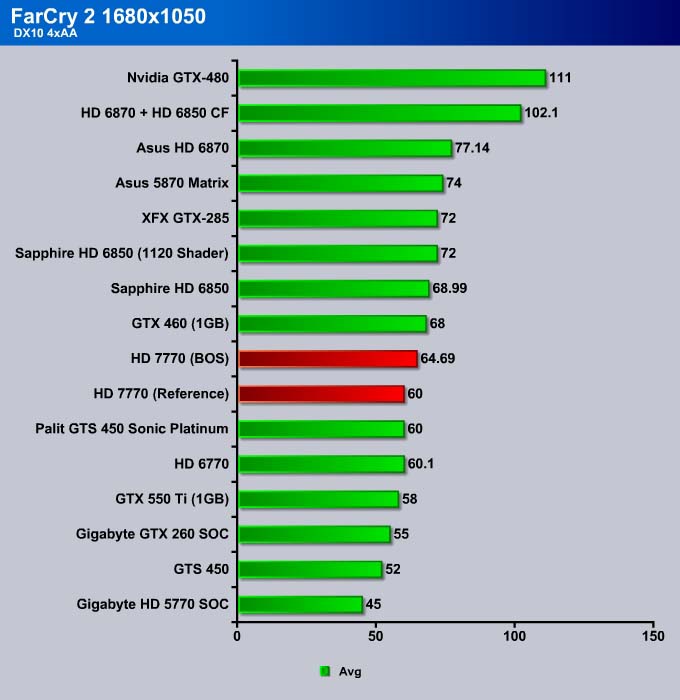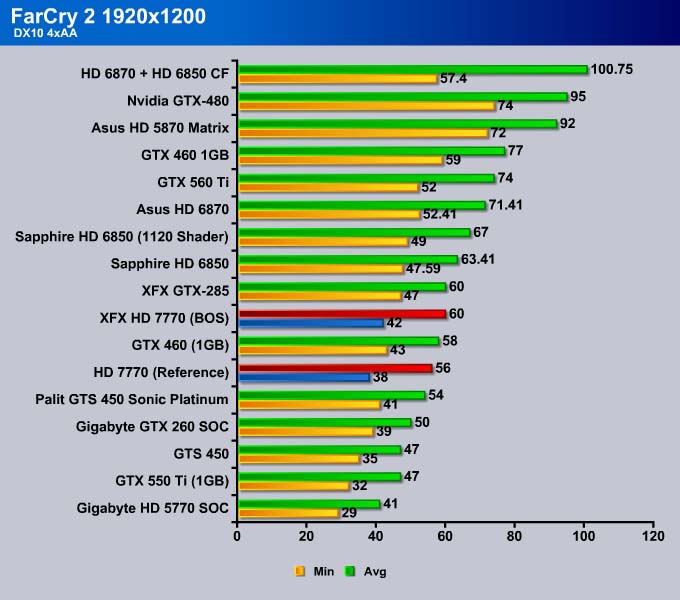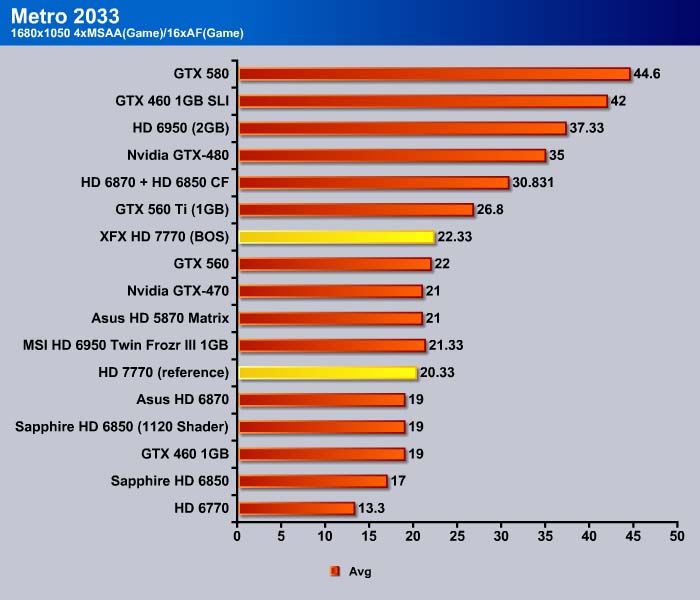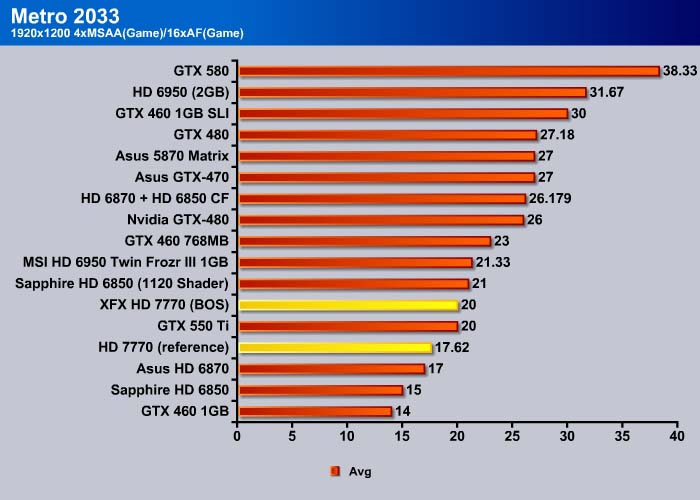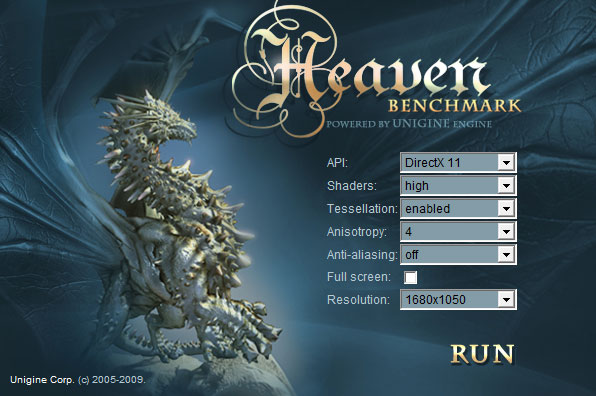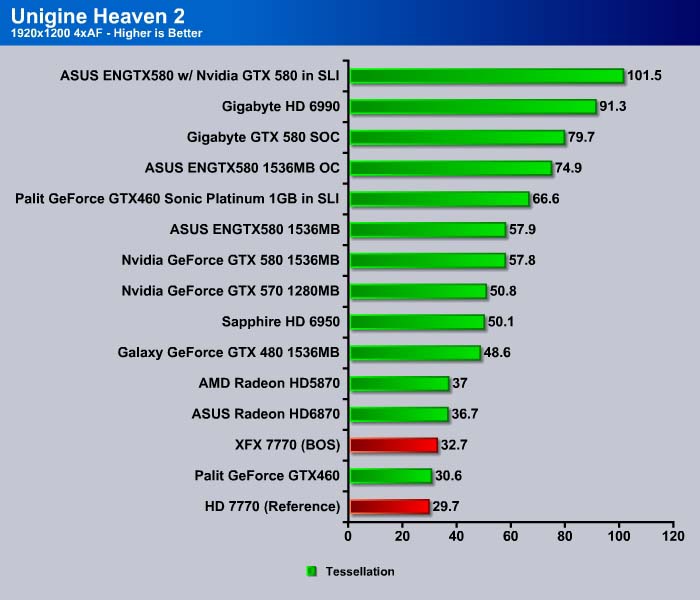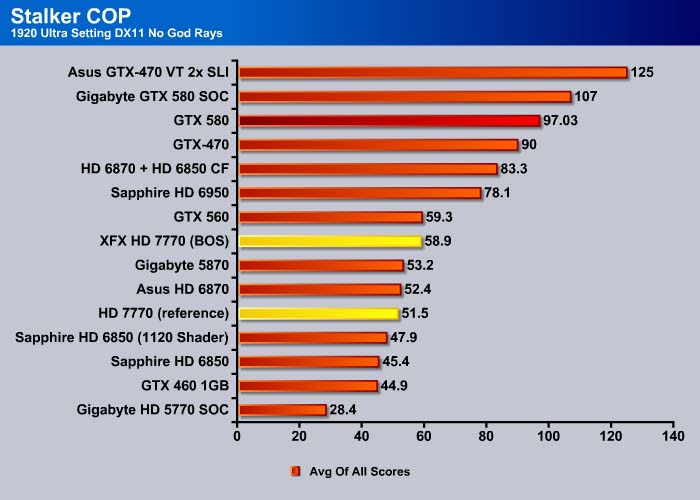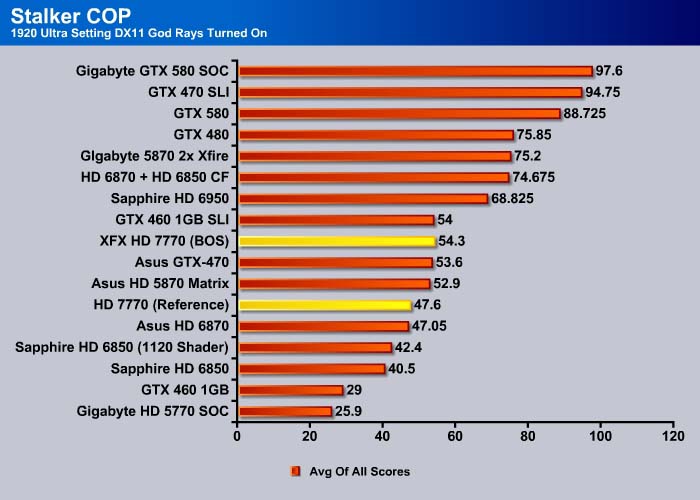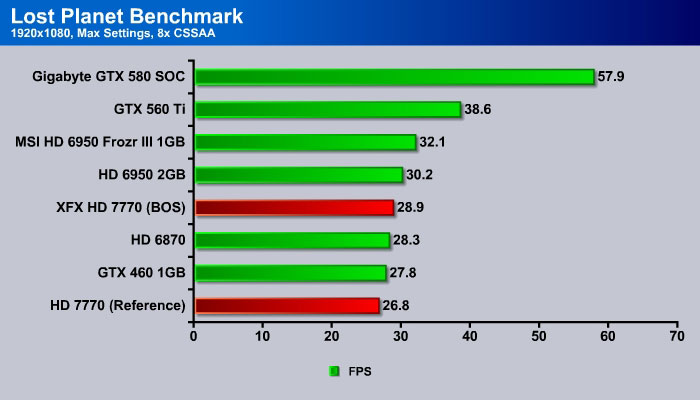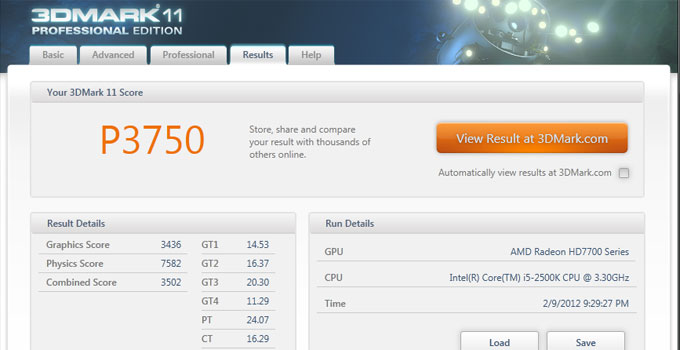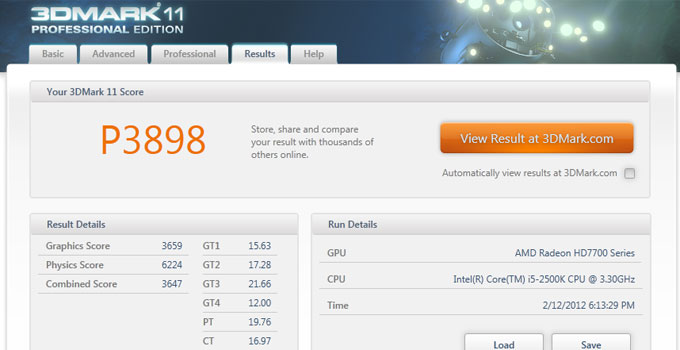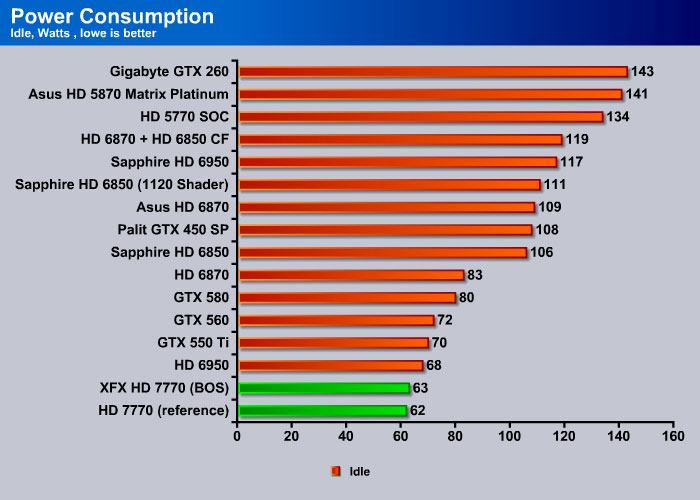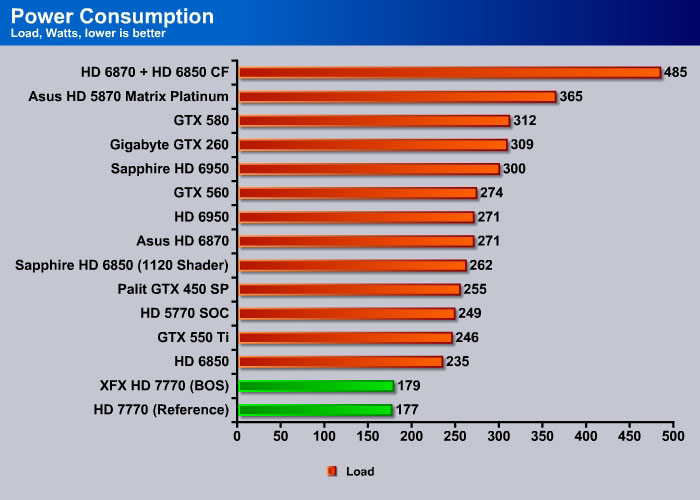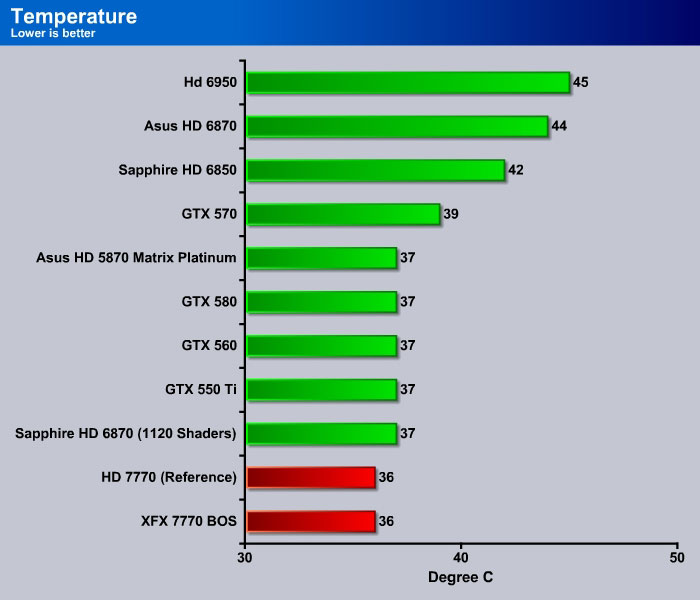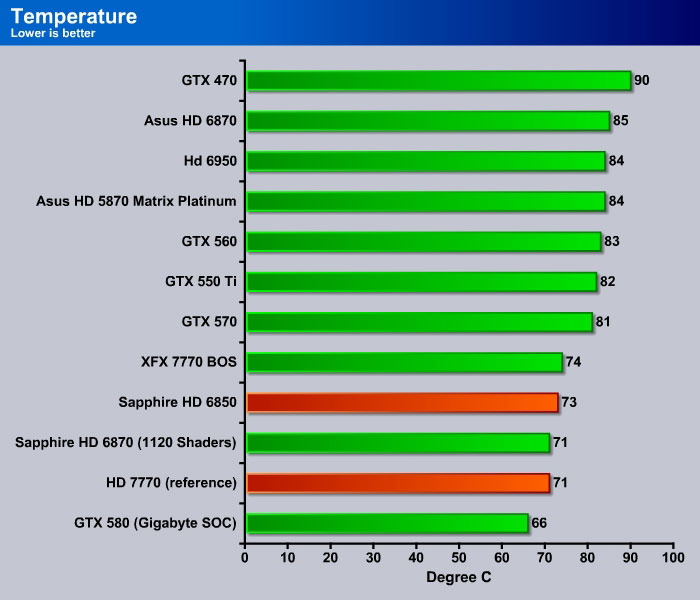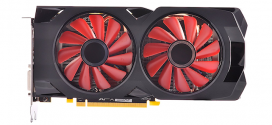Overclocked to 1.12 GHz, the XFX R7770 Black Super OC Double Dissipation is one of the fastest factory overclocked cards available for the HD 7770.
INTRODUCTION
The Radeon HD 7900 series, codenamed Tahiti, was the first product off the Southern Island family of GPUs that AMD launched on December 22, 2011. This marks a new era of GPU architecture from AMD as it ushers in the Graphics Core Next (GCN), which brings a greater computing power to the GPU. Based on a completely new design, the Southern Island’s stream processors are organized in AMD’s SIMD-based GNC architecture, which is AMD’s answer to NVIDIA’s Fermi architecture.
Tahiti was the first 28nm GPU manufactured by TSMC. It is also the first card that supports PCI-E 3.0 and Direct3D 11.1. The end result was that not only is Tahiti the most powerful GPU on the market today, its computing power has been improved significantly.
As always, once the high performance cards appeare on the market, both NVIDIA and AMD will release mainstream derivatives based on the same architecture and technology except a few features or functional unit disabled to make ways for the mainstream and budget products.
With Tahiti out of the gate, AMD is ready to show off the Cape Verde, the mainstream cards targeted at $100-200. Often times, companies release the top-of-the-line cards first, followed by midrange cards, followed by the entry-level. This time, however, AMD went straight to the bottom first after launching the Tahiti. AMD still has plans to release mid-level cards but that will have to come at a later time, and today is all about Cape Verde. Two cards will be launched today: the HD 7770 and the HD 7750. The cards are designed as the successor to the HD 6870 and the HD 6850.
HD 7700 Series: Cape Verde
The last generation mainstream GPU from AMD—the HD 6870 and HD 6850 features fundamentally same 5-way VLIW architecture as the HD 5000 series. While AMD is able to tweak the card’s performance to keep it competitive, its aging architecture is long overdue for an overhaul. With the Cape Verde utilizing the same GCN design as the top of the line product, we should expect the card to have much more powerful computing power while its GPU power should stay relatively comparable.
Obviously since Cape Verde is based on the same architecture as Tahiti, we should expect the same features found on Tahiti to be on Cape Verde. This includes second generation Eyefinity, HD3D Technology, Supersample Anti-Aliasing, PowerTune Technology, ZeroCore Power Technology, Discrete Digital Multipoint Audio (DDMA), and AMD Steady Video 2.0. In addition, the GPU also supports FP64 but only limited to 1/16th FP32 performnace.
| Video Card | Radeon HD 7970 | Radeon HD 7770 | Radeon HD 7750 | Radeon HD 6870 | Radeon HD 6850 |
| GCN | 32 | 10 | 8 | — | — |
| Stream Processors | 2048 | 640 | 512 | 1120 | 960 |
| Texture Units | 128 | 40 | 32 | 56 | 56 |
| ROPs | 32 | 16 | 16 | 32 | 32 |
| Core Clock (MHz) | 925 | 1000 | 800 | 900 | 775 |
| Memory Clock | 1.375 GHz (5.5 GHz effective) | 1.125 GHz (4.5 GHz effective) | 1.125 GHz (4.5 GHz effective) | 1.050 GHz (4.2 GHz effective) | 0.775 GHz (3.1 GHz effective) |
| Memory Bus Width | 384-bit | 128-bit | 128-bit | 256-bit | 256-bit |
| Memory | 3GB GDDR5 | 1 GB GDDR5 | 1 GB GDDR5 | 1 GB GDDR5 | 1 GB GDDR5 |
| Manufacturing Process | TSMC 28nm | TSMC 28nm | TSMC 28nm | TSMC 40nm | TSMC 40nm |
Like its bigger brother, the Cape Verde also supports a wide range of ports which includes HDMI 1.4a, 3GHz and DP 1.2 HBR2. Up to 4096×2160 (UHD) displays are supported.
The HD 7700 series cards all feature 512KB of L2 Read-Write cache, and 16 ROPs. Packed in are 1.5 billion transistors. The bigger of the two cards, the HD 7770 has 10 Compute Units (CU) for a total of 640 Stream Processors. The GPU is clocked at 1GHz with 1GB of 128-bit GDDR5 clocked in at 1,125MHz (4500 effective). This works out to be 72GB/s memory bandwidth and 1.28 TFLOPS of computing power. At 1GHz clockspeed, the HD 7770 is, in fact, the first factory clocked GPU on the market. AMD rates the card’s typical power consumption to be 80 watts while consuming less than 3 watts of long idle power.
The HD 7750 is going to be the lowest end for the current generation of architecture GCN form AMD. The card will have 512 stream processors. The GPU is clocked at 800MHz with 1GB of 128-bit of GDDR5 running at 1,125 MHz (4500 effective). AMD quotes the card to have a typical 55W of power consumption with less than 3 watts of long idle power. The card will have 819 GFLOPS of compute performance and 72GB/s memory bandwidth.
AMD’s launching price for the HD 7750 and the HD 7770 are $109 and $159 respectively. The pricing of the card puts the HD 7770 in direct competition against AMD’s own HD 6850 and HD 6870. The pricing of the card also means that the card should be faster than NVIDIA’s GTX 550 Ti and slower than the GTX 560.
XFX HD 7770 Black Editions Super Overclocked Double Dissipation
| Model | Part Number | Overclocked | Dual Fan |
| Radeon™ HD 7770 Core Edition | FX-777A-ZNF4 & FX-777A-ZNFC | No | No |
| Radeon™ HD 7770 Double Dissipation Edition |
FX-777A-ZDF4 & FX-777A-ZDFC | No | Yes |
| Radeon™ HD 7770 Black Edition | FX-777A-ZNB4 & FX-777A-ZNBC | Yes (1095 MHz GPU) | No |
| Radeon™ HD 7770 Black Edition featuring Double Dissipation | FX-777A-ZDB4 & FX-777A-ZDBC | Yes (1095 MHz GPU) | Yes |
| Radeon™ HD 7770 Black SuperOverclocked Edition featuring Double Dissipation | FX-777A-ZDSC | Yes (1120 MHz GPU) | Yes |









TESTING & METHODOLOGY
To test the HD 7770 we did a fresh load of Windows 7 Ultimate, applied all the updates we could find, installed the latest motherboard drivers for the board, updated the BIOS, and loaded our test suite. We didn’t load graphics drivers because we wanted to pause to clone the HD with the fresh load of Windows 7 without graphic drivers. That way we have a complete OS load with testing suite and it’s not contaminated with GPU drivers. Should we need to switch GPU’s or run CrossFire, later all we have to do is clone our drive and install GPU drivers and we are good to go.
We ran each test a total of 3 times and report the average here. In the case of a screenshot of a benchmark we ran the benchmark 3 times, tossed out the high and low and post the median result from the benchmark. Any erroneous results were discarded and the test was rerun.
Test Rig
| Test Rig | |
| Case Type | None |
| CPU | Intel Core i5 2500K |
| Motherboard | Gigabyte Z68XP-UD3-iSSD |
| Ram | Kingstone HyperX 1600 |
| CPU Cooler | Prolimatech Megahalem |
| Hard Drives | Seagate 7200.11 1.5 TB |
| Optical | None |
| GPU | XFX R7770 Black Edition Super Overclocked Double Dissipation (HD 7770 BOS) GTX 560 GTX 550 Ti HD 6870 GTX 460 Sapphire HD 6850 GTX 480 GTX 580 Gigabyte HD 5770 Super Overclock Asus HD 5870 Matrix Platinum GTX 460 1GB Palit GTS 450 Sonic Platinum Drivers for Nvidia GPU’s 263.09 Drivers for ATI GPU’s 10.12 |
| Case Fans | 120mm Fan cooling the MOSFETs and CPU |
| Docking Stations | None |
| Testing PSU | Cooler Master UCP 900W |
| Legacy | None |
| Mouse | Microsoft Intellimouse |
| Keyboard | Logitech Keyboard |
| Speakers | None |
Synthetic Benchmarks & Games
| Synthetic Benchmarks & Games | |
| 3DMark Vantage | |
| 3DMark 11 | |
| Crysis Warhead 2 | |
| Stalker COP | |
| Unigine Heaven v.2.0 | |
| Far Cry 2 | |
| Metro 2033 | |
| Lost Planet 2 | |
Our benchmarks are very comprehensive, including DX10, DX11, and Tessellation. We wanted as wide a representative sample as possible in the time available.
3DMARK VANTAGE
3DMark Vantage is a DirectX 10 synthetic benchmark. While Synthetic benchmarks may not always give us actual performance, it is nonetheless still able to give us a relative position of a card’s performance.
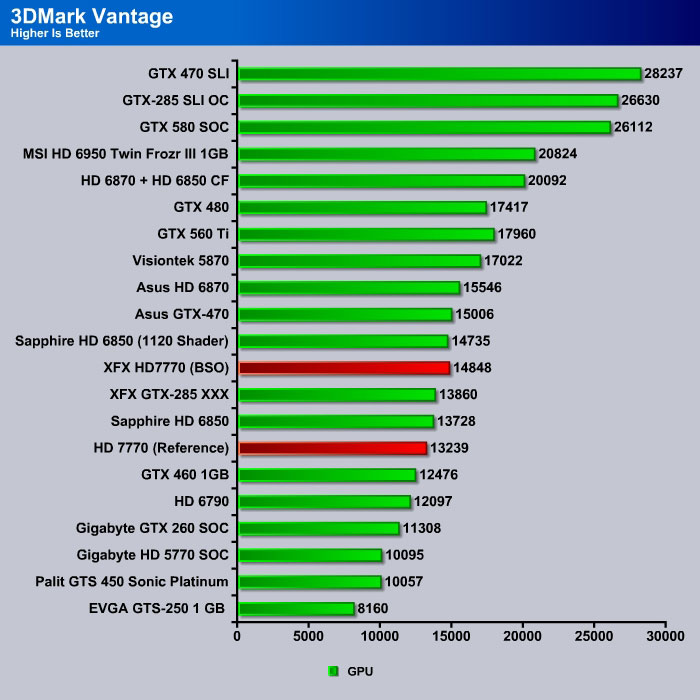
3DMark Vantage shows the reference clocked HD 7770 is faster than the GTX 560 but it is not as fast as the HD 6850. The XFX HD 7770 BESO, on the other hand, is able to edge out the HD 6850 and come close to the HD 6870.
3DMARK 11
“3DMark 11 is the latest version of the world’s most popular benchmark for measuring the graphics performance of gaming PCs. Designed for testing DirectX 11 hardware running on Windows 7 and Windows Vista the benchmark includes six all new benchmark tests that make extensive use of all the new features in DirectX 11 including tessellation, compute shaders and multi-threading. After running the tests 3DMark gives your system a score with larger numbers indicating better performance. Trusted by gamers worldwide to give accurate and unbiased results, 3DMark 11 is the best way to test DirectX 11 under game-like loads.”
Like what we have seen with the 3DMark Vantage, the 3DMark 11 shows the similar result here.The HD 7770 is about 90% of the performance of the HD 6850. With overclocking, the XFX card is able to yield about the same performance as the HD 6850.
CRYSIS WARHEAD
Crysis Warhead is the much anticipated standalone expansion to Crysis, featuring an updated CryENGINE™ 2 with better optimization. It was one of the most anticipated titles of 2008. Crysis is no longer the most demanding games on the market. However, it is a favorite game for many gamers. The game is a very good benchmark to test to see how a video card will perform, especially under DirectX 10.


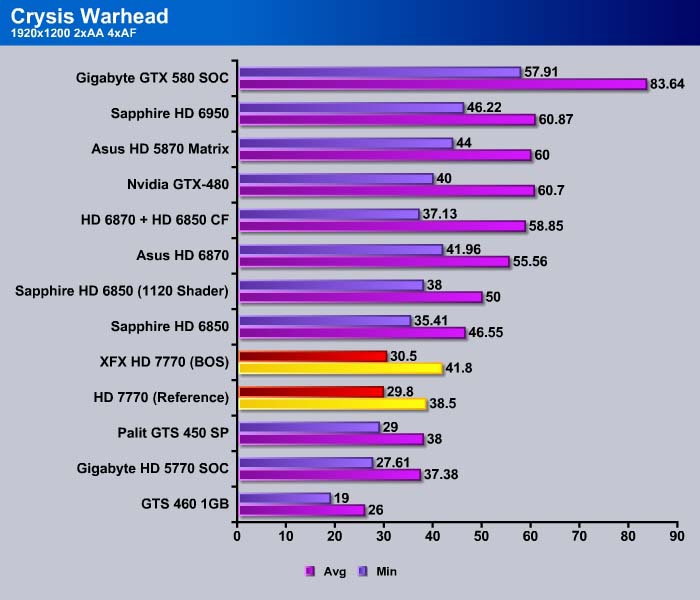
FAR CRY 2
Far Cry 2, released in October 2008 by Ubisoft, was one of the most anticipated titles of the year. It’s an engaging state-of-the-art First Person Shooter set in an un-named African country. Caught between two rival factions, you’re sent to take out “The Jackal”. Far Cry2 ships with a full featured benchmark utility and it is one of the most well designed, well thought out game benchmarks we’ve ever seen. One big difference between this benchmark and others is that it leaves the game’s AI (Artificial Intelligence ) running while the benchmark is being performed.
A similar result is seen with the Far Cry 2. Looks like the HD 7770 may actually be slower for the DirectX 10 games. Compared against the GTX 550 Ti, it is clearly the better choice of the two as the card is about 20% faster than the GTX 550 Ti. Overclocking makes it runs about 10% faster. Still, the HD 6850 is the better performer especially considering that it can be purchased for a lower price at the moment.
METRO 2033
Metro 2033 is an action-oriented video game blending survival horror and first-person shooter elements. The game is based on the novel Metro 2033 by Russian author Dmitry Glukhovsky. It was developed by 4A Games in Ukraine and released in March 2010 for the Xbox 360 and Microsoft Windows. In March 2009, 4A Games announced a partnership with Glukhovsky to collaborate on the game. The game was announced a few months later at the 2009 Games Convention in Leipzig; a first trailer came along with the announcement. When the game was announced, it had the subtitle “The Last Refuge,” but this subtitle is no longer being used.
Metro 2033 is a shader intensive game and it is capable of utilizing the new architecture design on the HD 7770. Thus, the HD 7770 performs much better. In fact, the HD 7770 is able to edge out not only the HD 6850 but also the HD 6870 at 1680×1050 resolution. At higher resolution, the HD 7770 actually lost the battle to the GTX 550 Ti but the overclocked XFX card was able to tie the performance.
UNIGINE HEAVEN 2.5
Unigine Heaven is a benchmark program based on Unigine Corp’s latest engine, Unigine. The engine features DirectX 11, Hardware tessellation, DirectCompute, and Shader Model 5.0. All of these new technologies combined with the ability to run each card through the same exact test means this benchmark should be in our arsenal for a long time.
The HD 7770 performs somewhat poorly here. It is slower than the GTX 460 which is a year old, but the XFX card is able to edge out the GTX 460 by 5%.
S.T.A.L.K.E.R.: CALL OF PRIPYAT
Call of Pripyat is the latest addition to the S.T.A.L.K.E.R. franchise. S.T.A.L.K.E.R. has long been considered the thinking man’s shooter, because it gives the player many different ways of completing the objectives. The game includes new advanced DirectX 11 effects as well as the continuation of the story from the previous games.

S.T.A.L.K.E.R. is another test that puts the HD 7770 faster than the HD 6850. The new architecture really has an advantage when it comes to shader intensive applications.
Lost Planet 2
The reference clocked HD 7770 again lost to the GTX 460. However, the XFX card not only outperformed the GTX 460, it also edged out the HD 6870.
OVERCLOCKING
Overclocking is important to everyone, regardless of what they plan to do with a computer. Nearly all enthusiasts end up overclocking a computer at one point or another so it is always good to know what kind of performance each piece of hardware can achieve.
Since the XFX HD 7770 is already overclocked by 10% from the reference speed of 1GHz, we did not expect to be able to push the card much further. At a default voltage of 1.174, we were able to overclock the card’s GPU to 1240 MHz and memory to 1350 MHz and pass Furmark. However, when we ran 3DMark 11, the benchmark would crash. We had to back down the GPU clockspeed to 1165 MHz and we were able to run the benchmark. This is 16.5% overclock from the reference speed, which is not too bad. Looks like XFX has done their homework when comes to design the card. Bear in mind that XFX promises that the card will be at similar power consumption as the reference speed, so if users are willing to add more voltage (which increases the power consumption), it is very possible to push the GPU further.
Looking at the 3DMark11, we get 148 more points with our slight overclocking which translates to 4% gain in the performance.
Power Consumption
The power consumption was tested while running Furmark and with the AMD PowerTune set to 20%. The maximum power used during an extended time period test is what was used for the load values and the idle values were recorded after booting up the computer into Windows for at least 15 minutes.
HD 7770 consumes the least amount of power that we have seen so far with the discrete card. Putting the number in perspective, the integrated GPU on the Sandy Bridge Core i5 2500K on the H67 board consumes 49 watts of power so the add-on card adds about 15 watts of power. With long idle power, we should expect the card to reduce about 10 watts of power consumption.
The load power consumption is also the lowest. Thanks to the 28nm fabrication, AMD is able to trim down the power consumption while keeping the performance level of the last gen mid-range card.
Notice that the XFX card is able to achieve higher performance while only drawing 2 more watts of power. We really like that the XFX is able to achieve the 10% performance gain while keeping the same power consumption.
Temperature
The temperature was tested while running Furmark and with the AMD PowerTune set to 20%. The maximum temperature recorded during an extended time period test is what was used for the load values and the idle values were recorded after booting up the computer into Windows for at least 15 minutes.
Most current generation of cards runs at very cool idling and the HD 7770 is no exception, taking the lowest temperature we have measured.
Under load, we can see the card also performs quite well. The XFX HD 7770 peaked at 74C, 4 degrees higher than the reference speed.
Noise-level
We have got to say that we are absolutely loved the fac that the XFX HD 7770 runs very quiet. Both idle and load, the card really impressed us with the noise-level. It is one of the quietest card we have ever tested. Idle, the card’s fan runs at about 30% (1740 RPM) and it’s absolutely quiet. Under load, the fan only goes up to 46% (2700RPM). Despite running at 2700RPM, the noise is really not bothersome at all. We can hear the whispering fan noise with our open case test bench, which we believe would be hard to detect if the card is placed inside a case.
conclusion
What AMD brings to the table with the HD 7770 is the performance close to the HD 6850 yet at lower power consumption and greater computing power. Additionally, the card also brings DirectX 11.1, PowerTune, HD3D, and a slew of display ports.
Unfortunately, the pricing of the card makes it hard to sell especially for consumers looking for the best performance for the buck. With the performance-level similar to the HD 6850 and GTX 460, it essentially has the same performance as cards one to two years old. Making the matter worse, AMD priced the card to be higher than the HD 6850. The HD 7770 is really not a bad card when we account for all of the new features and its strength and performance but it really should be selling at below $140 at price similar or slightly below the HD 6850.
The HD 7770 is in direct competition from AMD’s own HD 6850 which is selling at a lower price point. For people who are looking to upgrade from GTX 460 or GTX 550 Ti, the HD 7770 is certainly worth considering. However, users who already own HD 6850 or HD 6870 should not upgrade to the HD 7770 unless they have an urgent need for lower temperatures or power consumption. With NVIDIA getting ready to release the next generation of GPU, the HD 7770 will be hard pressed to stay competitive in its current price bracket.
Now, let us consider the XFX HD 7770 Black Edition Super Overclocked Double Dissipation. As the card shows us, AMD has a room for improvement and with overclocking the performance of the card can be at the level or even better than HD 6850. In fact, the XFX HD 7770 really impressed us with its combination of performance, power consumption, and noise-level. We feel that if users are considering buying an HD 7770, we highly recommend looking at the XFX HD 7770 Black Edition Super Overclocked Double Dissipation.
| OUR VERDICT: XFX HD R7770 Black Edition Super Overclocked featuring Double Dissipation | ||||||||||||||||||
|
||||||||||||||||||
| Summary: With its 10% factory overclocking, the XFX R7770 Black Edition Super Overclocked Double Dissipation is able to perform at the level of the HD 6850, while maintaining the cooling and performance of the HD 7770. It is one of the coolest and quietest cards we have ever tested, earning it the Bjorn3D Seal of Approval. |
 Bjorn3D.com Bjorn3d.com – Satisfying Your Daily Tech Cravings Since 1996
Bjorn3D.com Bjorn3d.com – Satisfying Your Daily Tech Cravings Since 1996






